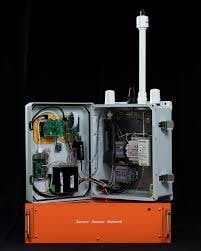Chattanooga Airport and Partners Plan “Dynamic Boundaries” Microgrid
Already a pioneer in municipal broadband and smart grid, Chattanooga, Tennessee, is now setting its sights on developing an airport microgrid that will employ an innovative, open-source controller.
The city’s utility, the Chattanooga Electric Power Board (EPB), and partners are working on a microgrid for the Chattanooga Airport that will link into existing automated switch gear and hence to the utility’s smart grid network.
Together, the open-source microgrid controller, automated switch gear and smart grid interconnection will create a microgrid with dynamic boundaries, according to Jim Glass, EPB smart grid development manager.
“Instead of the typical single interconnect point between a microgrid and a utility, this microgrid is actually using EPB’s distribution system to supply customer loads. The boundaries of the microgrid can expand or contract (using the automated switches) based upon the customer load forecast, the solar PV generation forecast and the battery state of charge,” Glass said.
Microgrid controller manages dynamic boundaries
The microgrid controller is being tested in the lab at University of Tennessee-Knoxville, which is also serving as the project’s lead manager. University professor of electrical engineering Fred Wang is the project’s principal point of contact, and he and his team are developing the code for the microgrid controller. National Instruments is supplying the microgrid controller hardware.
Plans are to integrate and test the controller on EPB’s network this summer, and make it part of the smart grid system if and when testing is successful, according to Glass.
“The uniqueness of this microgrid controller is the ability to manage flexible boundaries on the microgrid,” he said. “Most microgrid applications utilize a single interconnect point with the utility. This microgrid actually uses the utility facilities (existing distribution system) to form the microgrid, and it has multiple interconnect points.”
Because it’s an open source controller, anyone can make use of its software code to design and build a microgrid that incorporates solar PV, battery energy storage, smart grid technology or variations thereof. “An open source solution was important to ARPA-E (which is funding the project) in order to make the solution available to as many organizations as possible when it is complete,” Glass said.
The microgrid will incorporate a 560-kW battery, which EPB will own and operate, with 2.1 MW of existing solar photovoltaics (PV) at the airport.
For an inside look at the growing microgrid market, join us at Microgrid 2018 in Chicago May 7-9.
“The airport location was selected because of the existing solar PV. This was an ideal size installation on which to develop the microgrid,” Glass said.
Integrating the vanadium redox flow battery has proven to be something of a stumbling block, however. Problems arose during testing of the battery.
“The issue with the vanadium flow battery has not been resolved yet,” Glass explained. “The battery is undergoing extensive investigation by UniEnergy Technologies at their facility.”
From smart grid to airport microgrid
Expanding on the smart grid initiative, EPB earlier this year announced a project to collect real-time data from smart grid sensors to see fluctuations as they occur. Armed with this information, the utility can then take action to balance loads with online generation. Oak Ridge is leading the project, which includes participation by eight other national energy labs through the Department of Energy’s Grid Modernization Laboratory Consortium.
In addition to EPB’s automated switch gear, the Chattanooga Airport microgrid will make use of EPB’s fiber optic broadband communications network. It will be used to transport data and for both human and machine-to-machine communications — between the microgrid controller and automated switches, for example.
EPB’s smart grid investments – specifically installation of network-connected, automated switches – reduce the capital cost and time required to design and build the airport microgrid, Glass said.
Broad-based, public-private microgrid partnership
The project is EPB’s first experience with microgrid development and integration of distributed solar. Like many microgrids, the system is designed to enhance grid resiliency, reliability, efficiency and cost-effectiveness while lowering greenhouse gas emissions.
EPB is providing historical customer load data, solar PV data and the electrical model of its smart grid system in the vicinity of the airport microgrid, Glass said. The Chattanooga municipal utility is also responsible for the installation of the vanadium redox flow battery and the communications to all of the microgrid components.
Along with EPB, the project partners include the University of Tennessee-Knoxville, the TVA, the Electric Power Research Institute (EPRI), National Instruments and the Green Energy Corporation. The Advanced Research Projects Agency-Energy (ARPA-E), a U.S. research and development agency, is the project’s primary source of funding.
National Instruments is supplying the microgrid controller hardware. TVA and EPRI are providing their industry experience to the controller’s design. Green Energy Corp is coordinating the commercialization of the microgrid controller.
EPB is already gaining a great deal of knowledge and experience regarding solar microgrids and battery storage by participating in the airport microgrid project. The municipal utility foresees opportunities to apply all its learning to future projects that it may carry out, Glass told Microgrid Knowledge.
Chattanooga is the latest in a growing number of cities working on transportation and airport microgrid projects, among them Pittsburgh, where the Allegheny County Airport Authority has a solicitation underway for project partners.
Track news about airport microgrid projects. Subscribe to the free Microgrid Knowledge newsletter.








